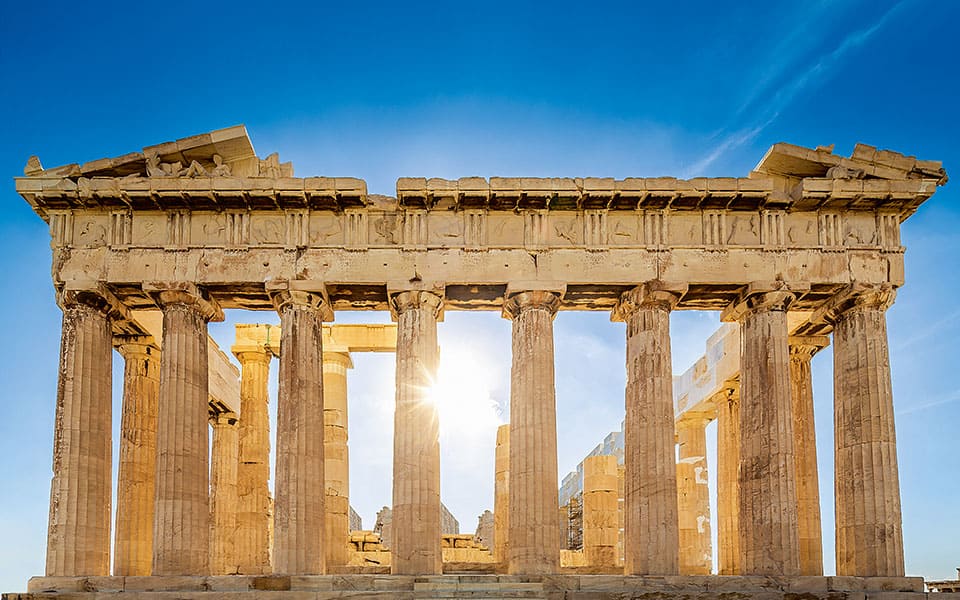
The Acropolis, perched high above the city of Athens, is a complex of ancient buildings that were constructed in the 5th century BCE during the Golden Age of Athens. The most notable highlights include the Parthenon, the Erechtheion, the Temple of Athena Nike, and the Propylaea. Each of these structures holds immense historical and architectural significance, reflecting the artistic and engineering prowess of the ancient Greeks.
The Parthenon, a temple dedicated to Athena, the patron goddess of Athens, is the centerpiece of the Acropolis. Its grandeur and the precision of its Doric columns symbolize the height of classical Greek architecture. The Erechtheion, known for its Caryatids—sculpted female figures that serve as columns—is another architectural marvel, showcasing the complexity and innovation of Greek design. The Temple of Athena Nike, although smaller, is significant for its Ionic columns and frieze depicting scenes of victory. The Propylaea serves as the grand entrance to the Acropolis, impressing visitors with its monumental scale and sophisticated design.
The Parthenon is arguably the most famous structure on the Acropolis. Constructed between 447 and 432 BCE, it is a temple dedicated to Athena Parthenos, the goddess of wisdom and warfare. The Parthenon exemplifies the Doric order, the simplest of the classical Greek architectural styles, characterized by sturdy columns and a lack of ornate detailing. However, its metopes and pediments are richly decorated with high-relief sculptures depicting scenes from Greek mythology, such as the birth of Athena and the battle between the gods and giants. The Parthenon also housed a colossal statue of Athena made of gold and ivory, created by the renowned sculptor Phidias.
The Erechtheion is another must-see structure, famed for its architectural complexity and historical significance. Built between 421 and 406 BCE, the Erechtheion was dedicated to both Athena and Poseidon, reflecting the diverse religious practices of ancient Athens. Its most striking feature is the Porch of the Caryatids, where six elegantly draped female figures replace traditional columns, supporting the roof with their heads. Each Caryatid is unique, demonstrating the high level of artistry achieved by ancient Greek sculptors. Inside, the Erechtheion housed sacred relics and was the site of various religious rituals.
The Temple of Athena Nike, constructed around 427-424 BCE, is a small but significant temple located on the southwest bastion of the Acropolis. This Ionic temple is dedicated to Athena Nike, the goddess of victory, and commemorates the Athenians’ triumphs over their enemies. The temple’s frieze depicts scenes of battles and victories, celebrating the martial prowess of the Athenians. Despite its size, the Temple of Athena Nike is an exquisite example of classical Greek architecture, showcasing the elegance and refinement of the Ionic order.
The Propylaea serves as the grand entrance to the Acropolis, constructed between 437 and 432 BCE. This monumental gateway consists of a central building flanked by two wings, incorporating both Doric and Ionic elements. The Propylaea’s imposing structure and architectural sophistication set the tone for the grandeur of the Acropolis. As you pass through its towering columns, you get a sense of the awe and reverence that the ancient Greeks felt when entering this sacred precinct.
Though not part of the original classical Acropolis, the Odeon of Herodes Atticus is a Roman-era theater located on the southwest slope of the Acropolis. Built in 161 CE by Herodes Atticus in memory of his wife, this impressive stone theater once hosted music concerts and theatrical performances. Today, it continues to be a vibrant cultural venue, hosting events such as the Athens Festival. The Odeon’s well-preserved architecture and its ongoing use as a performance space make it a fascinating blend of ancient and modern traditions.
The Acropolis of Athens is a treasure trove of ancient history and architectural brilliance. Each structure within this complex tells a unique story of the artistic and cultural achievements of ancient Greece. From the majestic Parthenon and the intricate Erechtheion to the elegant Temple of Athena Nike and the imposing Propylaea, every corner of the Acropolis offers a glimpse into the past.
When visiting the Acropolis, it is essential not to miss these highlights. They not only provide a deeper understanding of ancient Greek civilization but also allow you to appreciate the enduring legacy of this remarkable site. Whether you are an avid history enthusiast, an architecture aficionado, or simply a curious traveler, the Acropolis of Athens is sure to leave a lasting impression. As you explore this ancient wonder, you will find yourself transported to a time when art, culture, and intellect flourished, shaping the world we know today.
